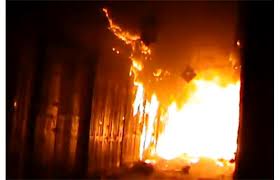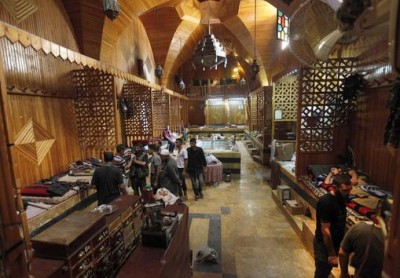 BEIRUT, Lebanon – Syria’s regime and rebels traded blame for a massive fire that continued Sunday to devour parts of Aleppo’s vast ancient market—a treasured commercial, historical and cultural hub—as angry residents tried to assess the damage.
BEIRUT, Lebanon – Syria’s regime and rebels traded blame for a massive fire that continued Sunday to devour parts of Aleppo’s vast ancient market—a treasured commercial, historical and cultural hub—as angry residents tried to assess the damage.
The fire’s origin was unclear, but coming days after rebels announced a fresh offensive to try to break the more than two-month stalemate in the battle for the strategic northern city, it is bound to further polarize Syria’s conflict-weary population.
Meanwhile, some members of Syria’s opposition began questioning the motives and tactics of the Aleppo insurgents who are ostensibly their allies. Some openly accused them of committing war atrocities and taking cover in congested residential neighborhoods and the old city—a Unesco World Heritage site—and using these areas to launch attacks on regime forces.
“People are worn out,” said an Aleppo native and senior member of the Syrian General Revolutionary Commission, a main opposition umbrella group. “It is the same back and forth, the government makes gains and the rebels reclaim a neighborhood; one side calls it cleansing and the other side calls it liberating and the people are paying for it.”
Pro-regime Syrian media didn’t mention the fire in their reports, only referring to continuing operations against “mercenary terrorists” in Aleppo.
The Aleppo native said members of the Tawhid Brigade, the main rebel group now fighting in Aleppo, have become rogue “armed gangs” that are only nominally associated with the Free Syrian Army. That army is itself a loosely linked grouping of local militias and defected military officers fighting Syrian President Bashar al-Assad’s regime across the country.
This summer, rebels launched a campaign to bring their fight into the heart of the capital, Damascus, and the country’s most populous city, Aleppo, for the first time.

Control over Aleppo is essential for any plan to create a haven for the opposition in the north, where rebels control much of the countryside.
Most Tawhid fighters came to Aleppo in July from rural predominantly Sunni Arab areas outside the city and harbor animosity toward an ethnically and religiously diverse urban population that has for the most part remained neutral in the conflict or supportive of Mr. Assad and his Shiite-linked leadership.
One of Tawhid’s leaders, defected army colonel Abdel-Jabbar al-Ughaidy, rejected the Aleppo native’s assessment during a telephone interview, blaming regime forces for instigating the attack in Aleppo’s old city.
Video footage posted by Syrian activists on YouTube Sunday—showing huge flames consuming thick wooden doors in the market, a warren of vaulted stone passageways—appeared to offer a more nuanced narrative.
A man, who identifies himself as a Free Syrian Army fighter, can be heard on the video saying that regime forces fired mortar and artillery shells at rebels amassed in the ancient market, causing the conflagration.
“They are shooting at us with snipers so that we do not extinguish the fire, these are people’s shops, their livelihood,” shouts the man as gunfire pops could be heard in the background.
Hassan Sheit, who owns an antique store in the market, said regime forces cordoned off the old city Sunday, keeping shopkeepers out as firetrucks and ambulances rushed in. He said both rebels and regime forces blamed each other for the fire, while some Aleppo residents were describing it as a “revenge attack” by rebels to punish merchants who have not supported them.Mr. Sheit, a Sunni Muslim, said he didn’t know his shop’s fate but that he spent most of the day comforting his Armenian-Christian neighbor whose jewelry store was lost in the fire. “He was sobbing like a child,” he said.
“Nobody is telling the truth,” said Mr. Sheit in a telephone interview. “The old city is the pulse of Aleppo, its heart.”
Residents fear that some of the almost 240 classified monuments in the old city might have been damaged by the fire, including its 13th century Antioch gate and the sprawling Ottoman-era Khan al-Jumruk, which once housed the trade missions and consulates of the British, Dutch and French imperial powers.
Aleppo is one of the world’s oldest continuously inhabited cities and was a key stop on the so-called Silk Road. Its walled old city, which incorporates the ancient souks, mosques, schools and the remains of cathedrals, is both a commercial hub and a tourist draw. It has undergone renovations in recent years funded by the German Organization for Technical Cooperation and the Aga Khan Foundation, among others.
WSJ
Leave a Reply
You must be logged in to post a comment.